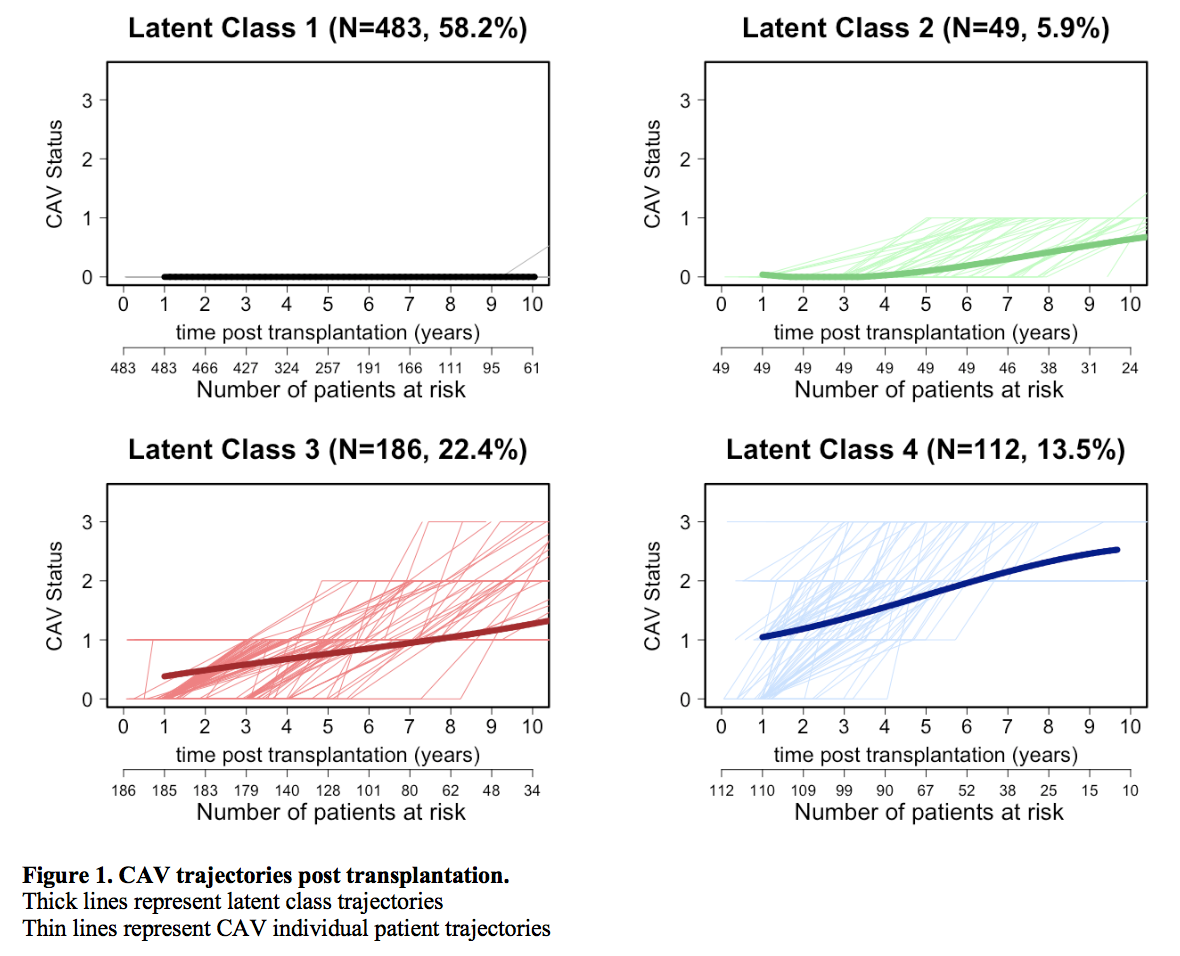Identification and Determinants of Cardiac Allograft Vasculopathy Trajectories after Heart Transplantation
1Paris Transplant Group, Paris, France, 2KU Leuven, Leuven, France, 3Pitie Salpetriere Hospital, Paris, France, 4Georges Pompidou Hospital, Paris, France, 5Saint Louis Hospital, Paris, France
Meeting: 2019 American Transplant Congress
Abstract number: 93
Keywords: Arteriosclerosis, Graft arterlosclerosis, Risk factors, Vascular disease
Session Information
Session Name: Concurrent Session: Medley of Heart Transplantation Topics
Session Type: Concurrent Session
Date: Sunday, June 2, 2019
Session Time: 2:30pm-4:00pm
 Presentation Time: 3:18pm-3:30pm
Presentation Time: 3:18pm-3:30pm
Location: Room 206
*Purpose: CAV is a major contributor of heart transplant recipient’s mortality. However, little is known about CAV long-term evolution profiles and their determinants. Such information would allow improved risk stratification of heart transplant patients.
*Methods: We enrolled 1,420 consecutive heart transplant patients from 3 referral centers in Europe (Pitie Salpetriere and Georges Pompidou Hospital in France and Leuven Hospital in Belgium) between 2004 and 2015. Angiograms were routinely performed in all included patients according to a prespecified protocol. CAV grades were measured using the 2010 ISHLT classification. Patients underwent an extensive evaluation comprising clinical, biological, histological (EMB), immunological (circulating anti-HLA DSA) parameters. Unsupervised Latent class mixed models were used to identify distinct trajectories of CAV progression. Multinomial regression analysis was used to determine the parameters associated with the CAV trajectories.
*Results: A total of 830 patients were included (615 in the French development cohort, 215 in the Belgian validation cohort). The median follow-up post-transplant was 7 years (IQR=5.1-9.0). In total 2,625 coronary angiograms were analyzed. We identified four distinct profiles of CAV trajectories post transplantation (Figure 1): CAV profile# 1 characterized by patients presenting with low baseline and non progression with time, CAV profile#2 characterized by patients with low baseline and slow CAV progression, CAV profile#3 characterized by patients with mild baseline CAV and mild progression, and CAVprofile#4 characterized by patients with mild baseline and accelerated CAV progression with time patients. Among the 60 parameters testes in univariate analysis, we identified 5 independent determinants of CAV progression: donor age (p<0.001), donor tobacco consumption (p=0.005), donor male gender (p<0.001), post-transplant dyslipidemia (p=0.02) and the presence of circulating anti-HLA DSA at the time of transplantation (p<0.001). Stratified analyzes showed that the 4 CAV profiles were similar in the French centers and the center from Belgium.
*Conclusions: In a large multicentric and highly phenotyped cohort of heart transplant recipients, we identify for the first time using unsupervised latent class method 4 distinct patterns of CAV trajectories and 5 independent factors associated with CAV progression overtime. This study provides fresh evidence of a trajectory-based assessment for improving risk stratification of heart transplant recipients.
To cite this abstract in AMA style:
Bonnet G, Coutance G, Racape M, Raynaud M, keer JVan, Bories M, Varnous S, Rouvier P, Guillemain R, Lecuyer L, Bruneval P, Duong-Van-Huyen J, Taupin J, Naesens M, Lefaucheur C, Jouven X, Loupy A. Identification and Determinants of Cardiac Allograft Vasculopathy Trajectories after Heart Transplantation [abstract]. Am J Transplant. 2019; 19 (suppl 3). https://atcmeetingabstracts.com/abstract/identification-and-determinants-of-cardiac-allograft-vasculopathy-trajectories-after-heart-transplantation/. Accessed December 14, 2025.« Back to 2019 American Transplant Congress

